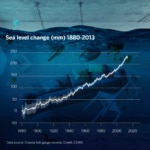How climate change threatens the Earth
The rise in the global temperature has negative effects on the planet - effects that are difficult to revert in some cases. Increasing frequent heat waves, devasating fires - like the recent fires in California - and natural disasters like tropical cyclones, floods and droughts, have had an enormous impact on the environment and socioeconomic development.

The climate crisis our planet is experiencing cannot be denied. The data confirm that human influence is the main cause of the changes underway on the Earth, and that the global average temperature has increased. In the last five years, the global average temperature is on its way to being the highest temperature for a five year period on record. It is estimated to be 1.1°C higher than the pre-Industrial period (1850–1900), according to the World Meteorological Organization. And its effects are increasingly evident.
According to the terms of the 2015 Paris Agreement , United Nations (UN) recommends that the global temperature increase does not exceed 1.5°C if we do not want the consequences to be even worse. Reducing greenhouse gas emissions is therefore fundamental..
Social and environmental consequences
This increase in temperatures has decreased polar ice caps, among other things. “In the last 30 years, the Arctic region has lost 10 percent of its ice volume and several studies have revealed that the thawing is taking place faster than we thought. This has another direct consequence: rising sea level,” says Mar Gómez, the Head of the Meterology Area at Eltiempo.es.
According to the Intergovernmental Panel on Climate Change’s (IPCC) research, sea levels could rise between 30 and 60 cm between now and 2100 even if greenhouse gas emissions are drastically reduced and global warming remains below 2 °C. If greenhouse gas emissions continue to rise at the current rate, the increase in sea level could be between 60 and 110 cm.

“The consequences of this rising sea level is, and will be, the flooding of costal areas, producing erosion, and threatening cropland and homes. This could cause mobilizations and migrations of poulation centers that will no longer be able to live where they used to,” warns Gómez. By 2050, around 570 costal cities are predicted to be at risk from rising sea level, which would affect approximately 800 million pepole. There are even islands, like the Maldives, that could completely disappear.
In the Special Report on the Ocean and the Cryosphere in a Changing Climate, the IPCC confirms that the warming of the ocreans and the chemical changes have already led to alterations in species at all levels of the ocean’s food chain. This has reprecussions on marine ecosystems and on the people who depend on them. “Climate change is considered one of the greatest threats to biodiversity in the world,” recalls Gómez. “The increase in global temperature and the rising frequency and intensity of extreme weather events has a direct impact on the ecosystems and the beings who live in them.”
Southwestern Austria and the Amazon are some of the natural areas that will be impacted the most. Furthermore, it is especially difficult on some species like the polar bear, which is directly affected by the Arctic ice; turtles, whose nests are affected by rising sea levels; and snow leopards, whose population has decreased 20 percent in the past two decades.
Moreover, glacial retreat will hinder entertainment and tourism activities and the cultural heritage of threatened regions. “What happens to the planet has direct reprecussions on all of us. The increase in extreme events will cause what is now known as climatic migrations. This will produce alternations in our society, such as adapation by those who are displaced and by the population that experiences a demographic increase,” maintains the meteorologist.
Another effect of climate change will be less water of lower quality in certain regions, with reprecussions on the health of their inhabitants and in sectors such as agriculture and hydroelectricity. “Sectors like agriculture and livestock could be highly affected by the increase in flooding, storms or droughts, with reprecussions on food production and supply.”
The group of UN experts has stated that better management of the Earth’s resources could contribute to the fight against climate change, but it isn’t the only solution. Reducing greenhouse gas emissions in all sectors is essential to maintain global warming, preferably below 1.5°C. “We will have to change our way of life and start adapting ourselves now to the climate change we are experiencing,” concludes Gómez.
Cover photo: ETIENNE LAURENT/EFE/lafototeca.com